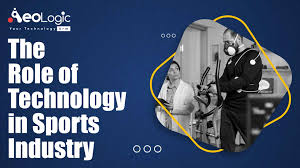In today’s fast-paced sports environment, technology has become a powerful ally for athletes and coaches worldwide. From advanced data analytics to wearable devices and AI-driven training platforms, technology continues to redefine the boundaries of human performance. Just like how platforms such as luongsontv have revolutionized how fans follow their favorite matches online, cutting-edge tech innovations are transforming how sports professionals train, recover, and excel on the field. This integration of science and technology ensures that every movement, decision, and performance metric can be measured and optimized for excellence.
Advanced Data Analytics: The New Coaching Revolution
Data analytics has dramatically changed the way coaches and players understand performance. Every action an athlete takes—from sprint speeds to passing accuracy—is now measurable, thanks to sophisticated tracking tools and software systems.
- Performance Tracking Systems: Cameras and sensors capture player movements in real-time, offering insights into strengths and weaknesses.
- Predictive Modeling: Using AI-driven models, teams can predict outcomes based on previous performances, helping to make smarter tactical decisions.
- Customized Training Plans: Data analytics allows coaches to design individualized programs tailored to a player’s unique physiological and technical profile.
- Game Analysis Tools: Platforms provide post-match analysis that breaks down every play, enabling athletes to review and improve strategically.
By harnessing these tools, teams can move beyond guesswork, ensuring every decision is backed by empirical data rather than instinct alone.
Wearable Technology: Real-Time Insights for Peak Performance
Wearable technology has become an indispensable part of modern sports. Devices like smartwatches, GPS trackers, and biometric sensors collect real-time data that help athletes optimize their performance and health.
- Heart Rate Monitors: Track cardiovascular performance to prevent overtraining and fatigue.
- GPS Trackers: Measure distances covered, speed, and positional accuracy during games or training.
- Sleep and Recovery Trackers: Ensure players get enough rest to maintain consistency and avoid injuries.
- Biomechanical Sensors: Analyze motion and posture, helping refine athletic technique for better efficiency.
With this data, coaches and trainers can identify potential injury risks early, fine-tune training loads, and ensure players are performing at their physical best.
Artificial Intelligence and Machine Learning: Smarter Training Decisions
Artificial Intelligence (AI) and Machine Learning (ML) are reshaping how athletes train and compete. These technologies help convert complex data into actionable insights, allowing teams to make smarter, faster, and more precise decisions.
- AI Video Analysis: Automatically identifies patterns in a player’s movement or tactical play.
- Machine Learning Algorithms: Learn from past performances to recommend optimal strategies and positioning.
- Virtual Coaching Assistants: Provide personalized feedback and training guidance in real time.
- Injury Prediction Models: Use data trends to alert medical teams about potential health concerns before they become serious.
Through these intelligent tools, athletes are empowered to improve continuously while reducing the risks associated with intense training schedules.
Virtual Reality and Augmented Reality: A New Dimension in Training
Virtual Reality (VR) and Augmented Reality (AR) are redefining sports training by offering immersive and interactive experiences. Athletes can now train mentally and physically without being on the actual field.
- Simulated Game Scenarios: VR recreates real match conditions, helping athletes practice decision-making under pressure.
- Skill Enhancement: AR overlays visual cues to correct technique during training sessions.
- Cognitive Development: VR improves mental focus, reaction time, and tactical awareness through simulation-based drills.
- Team Strategy Visualization: Coaches use AR to demonstrate plays and formations interactively.
These technologies provide a safe yet realistic environment for players to sharpen their reflexes, enhance teamwork, and prepare for real-world competition.
Biomechanics and Motion Analysis: Perfecting Every Movement
Biomechanics, powered by motion analysis technology, allows athletes to examine every movement in detail. This technology helps optimize performance while reducing injury risks.
- 3D Motion Capture Systems: Track and record the precise motion of body parts during physical activity.
- Force Plate Technology: Measures the power, balance, and impact forces generated by players.
- High-Speed Cameras: Record movements at thousands of frames per second for accurate technique evaluation.
- Kinematic Analysis Software: Provides visual breakdowns that help coaches and athletes improve technique precision.
By analyzing biomechanics, sports scientists can refine a player’s posture, stride, or swing, ensuring efficiency and maximum performance in every action.
Sports Broadcasting and Live Analysis: Bridging Technology and Fans
The technological impact doesn’t stop at training—it extends to how sports are consumed by audiences worldwide. The rise of digital platforms and trực tiếp bóng đá services has brought fans closer to the game than ever before. These broadcasting technologies not only enhance viewer experience but also provide real-time analytical insights for athletes and teams.
- Live Data Streaming: Enables instant access to performance metrics during matches.
- Interactive Fan Engagement: Viewers can analyze player statistics or vote for MVPs in real time.
- Enhanced Commentary Tools: AI-powered graphics and insights provide a deeper understanding of gameplay.
- Performance Reviews During Matches: Coaches and players can review live footage for immediate tactical adjustments.
This synergy between live technology and sports performance ensures that athletes are continuously aware, connected, and evolving alongside their fans.
Nutrition and Recovery Technology: The Science Behind Sustained Performance
In modern sports, recovery and nutrition are as important as training itself. Technology has made it possible to monitor how an athlete’s body responds to diet, sleep, and exercise, ensuring sustainable peak performance.
- Smart Nutrition Apps: Track calorie intake and suggest personalized diet plans.
- Hydration Sensors: Measure sweat levels to ensure optimal hydration during and after play.
- Cryotherapy and Recovery Pods: Speed up muscle recovery and reduce inflammation.
- AI-Based Recovery Analysis: Monitors fatigue levels and recommends rest periods.
These tools help athletes maintain energy, recover faster, and avoid burnout—essential for long-term career success.
The Future of Sports Technology: A Continuous Evolution of Human Potential
The evolution of technology in sports is just beginning. As innovations continue to emerge, the relationship between human capability and digital assistance will become even more seamless. Future developments such as AI-enhanced wearables, brain-computer interfaces, and smart training environments will redefine athletic excellence.
- Integration of 5G and Cloud Computing: Enables instant data transmission and remote coaching in real time.
- Neurotechnology Applications: Help athletes strengthen mental resilience and concentration.
- Advanced Performance Forecasting: Predicts long-term player development using AI and genetics data.
- Eco-Friendly Smart Stadiums: Combine sustainability with cutting-edge fan engagement technologies.
The future points toward a world where every athlete has access to personalized, data-driven, and environmentally responsible tools to perform at their absolute best.
A More Insightful and Powerful Conclusion on How Technology Continues to Shape the Future of Sports Performance
In conclusion, technology has evolved from being an external tool into an integral component of sports excellence. From real-time analytics and wearable trackers to VR training and AI-powered decision-making, every innovation contributes to unlocking new levels of performance. The collaboration between athletes, coaches, and technology has created an environment where precision, safety, and optimization coexist seamlessly.
The fusion of human skill and digital intelligence not only enhances training and recovery but also redefines what it means to compete. As the sports world continues to embrace these innovations, the gap between potential and performance narrows dramatically. Ultimately, technology ensures that the athletes of tomorrow will not only play harder but also smarter—ushering in a new golden era for global sports.

